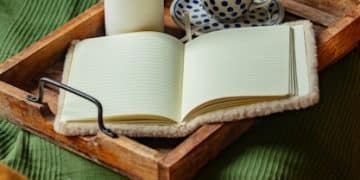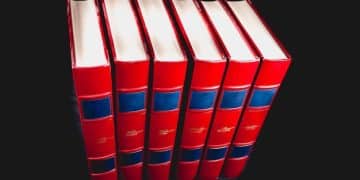The Ultimate Guide: Reading List for Writing Goals

The Ultimate Guide to Curating a Reading List That Aligns With Your Writing Goals offers a comprehensive approach to selecting books and articles that enhance your writing skills and guide you towards achieving your literary aspirations.
Are you a writer looking to enhance your craft? The Ultimate Guide to Curating a Reading List That Aligns With Your Writing Goals provides a structured approach to selecting books and articles that will improve your writing skills and help you achieve your literary aspirations.
Why Curate a Reading List for Writing Goals?
Starting a reading list with your writing goals in mind can transform your approach to writing. It’s not just about enjoying stories; it’s about learning the craft from the masters and exploring new techniques.
A curated reading list exposes you to a variety of writing styles, genres, and narrative structures. This exposure broadens your understanding of what’s possible in writing and helps you develop your unique voice.
Exposure to Diverse Styles
Reading widely introduces you to different voices and perspectives, enriching your own writing. Consider the following:
- Literary Fiction: Explore complex character development and thematic depth.
- Genre Fiction: Learn pacing and plot structure.
- Non-Fiction: Gain insights into research and clear communication.
Learning Narrative Techniques
Different authors use different techniques to tell stories. By analyzing these, you can:
- Identify effective dialogue techniques.
- Understand how to build suspense.
- Learn to craft compelling character arcs.
Ultimately, a curated reading list is a powerful tool for continuous learning and improvement as a writer. It provides a foundation of knowledge and inspiration that you can draw upon in your own work. By being intentional about what you read, you can accelerate your growth and reach your writing goals more effectively. It’s about learning, growing, and becoming the best writer you can be.

Identifying Your Writing Goals
Before diving into creating a reading list, it’s essential to define your specific writing goals. What do you want to achieve? What areas do you want to improve? Knowing your goals will help you select the most relevant and beneficial books and resources.
Consider your strengths and weaknesses as a writer. Are you struggling with dialogue, character development, plot construction, or descriptive prose? Identifying these areas will guide you in choosing books that directly address your needs.
Specific Goals Examples
Here are some examples of specific writing goals you might set:
- Improve Dialogue: Focus on books known for realistic and engaging conversations.
- Develop Complex Characters: Read character-driven novels and studies of character development.
- Master Plot Structure: Analyze successful plot structures in different genres.
Assess Current Skills
Take time to self-assess your current writing skills. Where do you excel, and where do you need improvement?
- Identify Strengths: Knowing your strengths can help you build on them.
- Recognize Weaknesses: Addressing weaknesses can elevate your overall writing quality.
By clarifying your writing goals and assessing your current skills, you can create a targeted reading list that supports your growth as a writer. The more focused your reading, the more effective it will be in helping you achieve your desired outcomes. This process ensures that your reading list isn’t just a collection of books, but a strategic tool for enhancing your writing abilities and reaching your literary ambitions.
Choosing Relevant Books and Articles
Selecting the right books and articles is crucial to creating an effective reading list. Look for materials that directly address your writing goals and provide valuable insights into your areas of interest.
Seek recommendations from trusted sources, such as writing communities, mentors, and authors you admire. These sources can offer valuable suggestions based on their own experiences and expertise.
Explore Different Genres
Don’t limit yourself to a single genre. Reading widely across different genres can expose you to new techniques and perspectives:
- Fiction: Learn about storytelling, character development, and plot structure.
- Non-Fiction: Gain insights into research, argumentation, and clear communication.
- Poetry: Develop an ear for language and rhythm.
Utilize Online Resources
The internet offers a wealth of information for writers. Take advantage of online articles, blogs, and courses:
- Writing Blogs: Follow reputable blogs that offer writing tips and advice.
- Literary Magazines: Read short stories and essays to see contemporary writing in action.
- Online Courses: Consider taking courses on specific aspects of writing, such as screenwriting or novel writing.
Choosing relevant books and articles involves research, exploration, and a willingness to step outside your comfort zone. The more diverse and targeted your reading, the more you’ll learn and grow as a writer. This approach ensures that your reading list is a valuable resource for your writing journey, providing you with the knowledge and inspiration you need to succeed. It’s about being proactive, curious, and committed to continuous improvement.

Effective Reading Strategies
Reading is more than just passively absorbing words; it’s an active process that requires engagement and critical thinking. To maximize the benefits of your reading list, adopt effective reading strategies that help you internalize and apply what you learn.
Take notes while you read, highlighting key passages and jotting down ideas that resonate with you. These notes will serve as valuable references when you’re ready to apply what you’ve learned to your own writing.
Active Reading Techniques
Engage with the text by asking questions, making connections, and analyzing the author’s choices:
- Highlight Key Passages: Mark sentences and paragraphs that stand out to you.
- Take Notes: Jot down your thoughts, questions, and insights as you read.
- Analyze Structure: Pay attention to how the author organizes the material.
Reflect on What You Read
After reading, take time to reflect on what you’ve learned and how you can apply it to your own writing:
- Summarize Key Points: Write a brief summary of the main ideas in the book or article.
- Identify Actionable Steps: Determine specific actions you can take to implement what you’ve learned.
- Experiment with New Techniques: Try incorporating new techniques into your writing practice.
Effective reading strategies are essential for transforming passive reading into an active learning experience. By engaging with the text, taking notes, and reflecting on what you’ve read, you can deepen your understanding and apply new knowledge to your writing. This approach ensures that your reading list is not just a collection of books, but a tool for continuous growth and improvement as a writer. It’s about being intentional, reflective, and committed to making the most of your reading experiences.
Integrating Reading into Your Writing Practice
The ultimate goal of curating a reading list is to integrate what you learn into your writing practice. Don’t let your reading remain abstract knowledge. Instead, find ways to apply the techniques and insights you’ve gained to your own work.
Experiment with different writing exercises that allow you to practice new skills and techniques. For example, if you’ve been reading about dialogue, try writing a scene that focuses on realistic and engaging conversations.
Apply New Techniques
Actively seek opportunities to incorporate new techniques into your writing:
- Rewrite Existing Passages: Revise your previous work using new insights from your reading.
- Experiment with Different Styles: Try writing in a style that is new to you.
- Seek Feedback: Share your work with other writers and ask for constructive criticism.
Reflect on Your Progress
Regularly reflect on your progress to see how your reading is influencing your writing:
- Keep a Writing Journal: Record your thoughts, observations, and challenges as you write.
- Track Your Growth: Compare your writing to previous work to identify areas of improvement.
- Adjust Your Reading List: Continue to refine your reading list based on your needs and interests.
Integrating reading into your writing practice transforms your learning into tangible improvement. By applying new techniques, reflecting on your progress, and adjusting your reading list, you can ensure that your reading has a direct and positive impact on your writing. This approach emphasizes action, experimentation, and continuous learning, helping you become a more skilled and versatile writer. It’s about bridging the gap between theory and practice, turning knowledge into mastery.
Maintaining and Updating Your Reading List
A reading list isn’t a static document; it’s a living, breathing tool that should evolve as your goals and interests change. Regularly review and update your reading list to ensure it remains relevant and beneficial to your writing journey.
Stay open to new recommendations and discoveries. Explore different genres, authors, and perspectives. The more diverse your reading, the more well-rounded you’ll become as a writer.
Regular Reviews
Schedule time to review your reading list and make adjustments:
- Assess Progress: Determine whether the books and articles on your list are helping you achieve your goals.
- Remove Irrelevant Items: Eliminate books that are no longer aligned with your interests.
- Add New Recommendations: Include new books based on recommendations and discoveries.
Stay Curious
Maintain a sense of curiosity and exploration in your reading habits:
- Attend Literary Events: Participate in book clubs, author readings, and writing conferences.
- Follow Literary Blogs: Stay updated with the latest trends and recommendations in the writing world.
- Engage with Writing Communities: Connect with other writers to share ideas and recommendations.
Maintaining and updating your reading list ensures that it remains a valuable resource for your writing journey. By regularly reviewing, adjusting, and staying curious, you can keep your reading list fresh, relevant, and aligned with your evolving goals and interests. This dynamic approach ensures that your reading continues to inspire, inform, and improve your writing, helping you reach your full potential. It’s about adaptability, curiosity, and a commitment to lifelong learning.
| Key Point | Brief Description |
|---|---|
| 🎯 Define Goals | Identify specific writing goals to target reading. |
| 📚 Relevant Books | Choose materials that directly address writing skills. |
| ✍️ Active Reading | Engage with text, take notes for better learning. |
| 🔄 Update List | Regularly review and update the reading list. |
Frequently Asked Questions
▼
Ideally, review your list quarterly. Assess if books align with your goals. Remove irrelevant items and add new recommendations discovered in reviews.
▼
Don’t force yourself to finish; remove it. Reading should be enjoyable and beneficial. Replace the book with something more relevant to keep learning.
▼
No, explore diverse genres to enhance writing skills. Different styles and perspectives broaden your storytelling and provide unique insights you may not discover otherwise.
▼
Use a reading journal to jot down notes, insights, and reflections. Also, consider using tools like Goodreads to organize completed books and track reading.
▼
Schedule dedicated reading time. Even 15-30 minutes daily can accumulate significantly. Use commute time with audiobooks. Make reading a priority by finding what suits you.
Conclusion
Curating a reading list that aligns with your writing goals is a powerful strategy for enhancing your craft and achieving your literary aspirations. By identifying your goals, choosing relevant books, adopting effective reading strategies, and integrating reading into your writing practice, you can transform your reading into a valuable tool for continuous growth and improvement.





